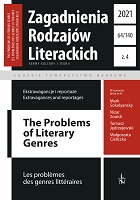Anakreontyki zaangażowane. Rozpoznania wstępne na dwóch przykładach
Militant Anacreontics. Preliminary Investigations of Two Examples
Author(s): Tomasz JędrzejewskiSubject(s): 18th Century, Theory of Literature, History of Art
Published by: Łódzkie Towarzystwo Naukowe
Keywords: Rococo; anacreontism; John Thelwall; Adam Mickiewicz;
Summary/Abstract: In a common reflection, Rococo is associated with the salon and courtly taste and lifestyle of the elite who liked to adorn themselves - as Stanisław Pietraszko wrote - with ‘the jewelery of literature’. The Rococo aesthetics was related to the sweetness of life of the ancien regime. Poems of this style presented moral extravagances of the aristocracy and rich bourgeoisie of the 18th century in different European countries. However, in the course of historical development, Rococo forms and motifs revealed their activist potential. This tendency was gaining momentum at the end of the 18th century and in the first decades of the 19th century. This article, attempts to show the forms of social and political engagement of Rococo literature using the example of three anacreontic poems. The verses by John Thelwall (Anacreontic, 1794) and Adam Mickiewicz (Pieśń Filaretów, 1820) are taken into consideration In each of these texts, the Rococo topoi take on new meanings and testify to the political dimension of the ‘toys in verse’. Symposiastic poetry enters into close relations with Romantic aesthetics. Anacreontics became an attractive genre of ideological expression of poets with democratic and pro-revolutionary inclinations.
Journal: Zagadnienia Rodzajów Literackich
- Issue Year: 64/2021
- Issue No: 4
- Page Range: 49-61
- Page Count: 13
- Language: Polish

